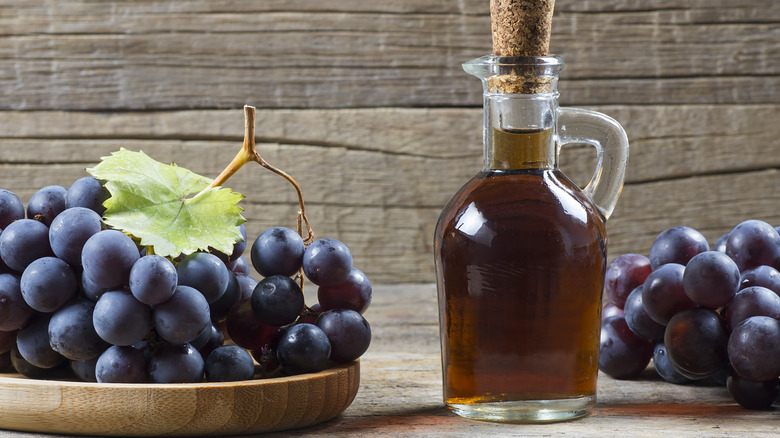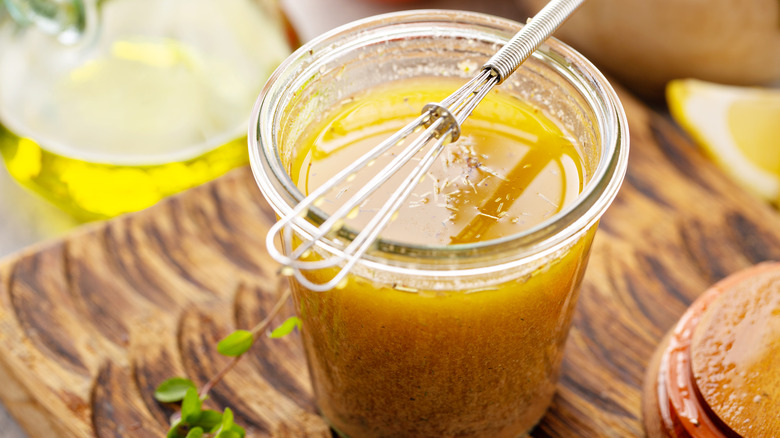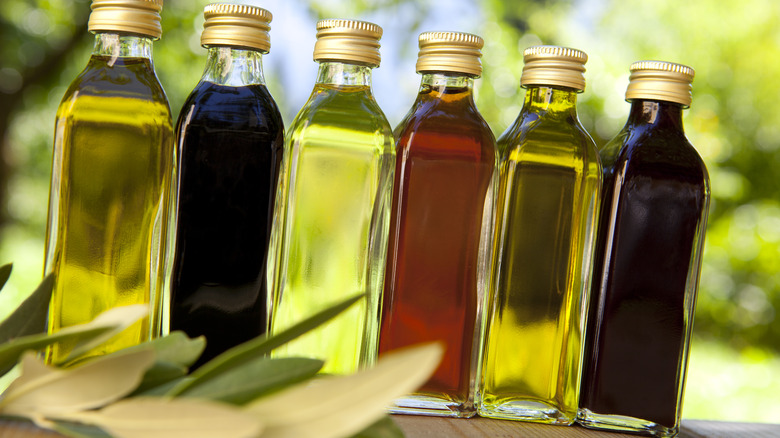What Is Malt Vinegar?
If you've ever been to a place with fish and chips on the menu, you're likely familiar with malt vinegar as a condiment. Malt vinegar can range from a light beige to a deep, caramel-brown hue. Compared to plain white vinegar, which is simply acid made from grain-based alcohol and water, malt vinegar offers a milder, sweeter, and more complex flavor profile. Like other vinegars, it's sold in bottles.
Malt vinegar has a long history, dating back to ancient civilizations that first discovered the process of fermentation. The word "vinegar" itself comes from the French term "vin aigre," which means "sour wine." Vinegar can be made from a variety of fermented foods, including grains, potatoes, fruits, and even honey, but malt vinegar specifically is made from the fermentation of malted barley or other grains. But while malt vinegar's origins are deeply rooted in ancient practices of fermentation, it is now a popular condiment in British cuisine. However, its utility extends beyond its traditional role in cutting through oily foods like fish and chips. For example, malt vinegar can be used to make an excellent gastrique-like sauce that you can slather over your favorite grilled meat.
How is malt vinegar made?
Just as the name suggests, the base for this vinegar is malt, a product made by starting the germination process of a grain, typically barley, although it can also be grains like rye or wheat. This process is halted by heating and drying the grain, which produces malted grains that lend a rich, nutty, toasty flavor to products like beer, milkshakes — in which it's added in powdered form mixed with powdered milk — and the vinegar we generously shake onto fish and chips.
Malt vinegar is made from ale, which is brewed using these grains. This process is similar to how red wine vinegar is made from wine. To produce malt vinegar, ale is brewed in the conventional manner, using malt, water, hops, and a yeast that ferments on top of the mixture. However, the brewing process is extended beyond the beer stage until it turns into vinegar.
Malt vinegar vs. wine vinegars
All types of vinegar start out as some form of alcohol. Beyond malt vinegar, which is made from beer, you've probably encountered white or red wine vinegar, as well as other varieties like apple cider vinegar. These are all made in similar ways: First, the alcoholic product is brewed, and then it's fermented — and sometimes aged — until the alcohol is gone. Just as beer, wine, and alcoholic cider each have distinct flavors, so do their respective vinegars.
Because they're made from grapes rather than barley, wine vinegars are typically fruitier and have a sharper acidity. In contrast, malt vinegar tends to be less sharp and a bit sweeter, offering more of a nutty, mellow flavor. While it is still acidic — this is vinegar, after all — it is more commonly added directly to foods, such as its popular use on fish and chips, compared to wine vinegars, which are more often used in marinades and sauces.
Of course, white and red wine vinegar have similar properties but are not identical. White wine vinegar tends to be lighter and is often used in settings where white wine would be appropriate, such as with salads. In contrast, the robust red wine vinegar is more likely to accompany meats.
What does malt vinegar taste like?
Malt vinegar tends to have a strong flavor but mild acidity. Expect a deep, slightly toasty flavor profile, courtesy of the malted grains that are a key ingredient. It generally has less acidic intensity compared to plain white vinegar. The flavor is sometimes described as having hints of citrus or caramel, along with a touch of sweetness.
The flavors can vary depending on the type of malt vinegar you buy. Dark malt vinegar has a darker color and features more caramelly notes and a more pungent flavor than other varieties. This type is commonly served with fish and chips. However, be cautious: Some "dark" malt vinegars may actually be dyed and lack robust flavor. Light malt vinegar has a lighter brown color and milder flavor notes, making it a better choice for sauces or dressings where it won't dominate other flavors. Finally, there's distilled malt vinegar, which is clear and similar to plain white vinegar. It's not generally used for adding flavor, but rather for imparting acidity to a recipe.
Aging can also affect the flavor profile of malt vinegar. Aged malt vinegar tends to be more mellow and rounded, while non-aged versions will be sharper and more tart.
How to cook with malt vinegar
Thanks to its relatively intense flavor, malt vinegar is often used as a standalone condiment, since its robust taste can overshadow other ingredients in marinades, sauces, and various recipes. It pairs exceptionally well with fried fish or potatoes, where its sharpness effectively contrasts with the oily or starchy elements of a dish.
However, it does work well in some recipes: British-style chutney is one context where malt vinegar commonly appears. It is also suitable for pickling and for making glazes — such as those for roasted meat dishes — where it's often used in conjunction with a sweet ingredient like honey, as well as herbs and spices.
Despite its intensity, malt vinegar can also appear in recipes for sauces, dressings, and marinades where other vinegars are typically used. Just be cautious with measurements to ensure that other ingredients get their chance to shine. Malt vinegar can replace other types for a deeper, richer flavor, and some recipes do specifically call for it.
Where to buy malt vinegar
If a supermarket or grocery store stocks malt vinegar, you'll generally find it in the condiment section, alongside other vinegar products. Occasionally, it might also pop up in the bakery aisle. If your supermarket has an international section featuring British goods, it's also worth checking there, given malt vinegar's prominence in British cuisine.
While it's not rare, malt vinegar may not be as readily available as other vinegar varieties, so you might need to search a bit more diligently. Some chains like Whole Foods and Publix do carry it — both in stores and online — although Costco typically does not. Stores specializing in British goods should also generally offer it, whether they operate online or as brick-and-mortar establishments. Prices can range from around $4 for a 12-ounce bottle to over $15 for a premium product. Additionally, a wide selection of malt vinegars is available on Amazon.
Nutritional information about malt vinegar
As a general rule, while vinegars may add acidity and flavor, they typically contain few nutrients, unless you opt for a blend with added ingredients. Most vinegars have minimal amounts of sodium and sugar, and they lack fat or protein. The caloric content of most vinegars is low, sometimes reaching up to 15 calories per tablespoon but often much less. The same is true for malt vinegar; for example, the Heinz brand contains no sugar, salt, or calories, while Sarson's, a popular British brand, has only trace amounts of sugar and salt.
Some health benefits are tentatively associated with vinegar. According to Healthline, limited research suggests that apple cider vinegar may help lower blood sugar levels. If you have celiac disease or a gluten sensitivity, you should avoid malt vinegar, as one of its key ingredients, barley, contains gluten. Furthermore, malt vinegar is free of animal products, making it suitable for vegans and vegetarians.







